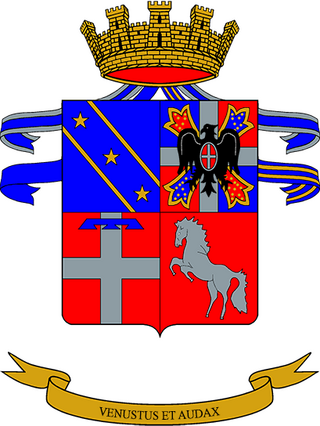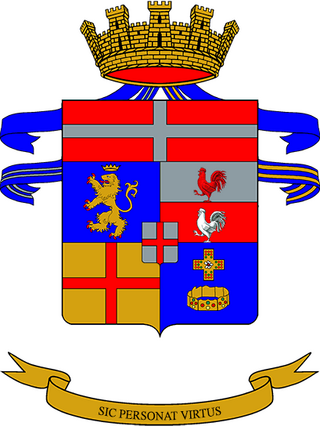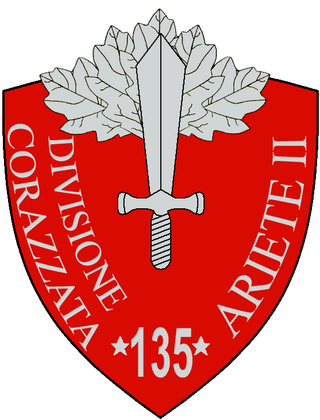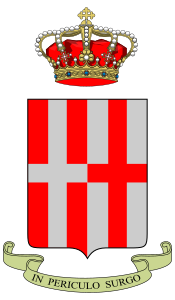
The Cavalry Brigade "Pozzuolo del Friuli" is a brigade of the Italian Army, based in the Friuli-Venezia Giulia and Veneto regions. The Brigade consists of a command unit, a cavalry regiment, an amphibious infantry regiment, an artillery regiment, an engineer regiment and a logistic regiment.

The Mechanized Brigade "Granatieri di Sardegna" is a mechanized infantry brigade of the Italian Army, based in Rome and central Italy. The brigade fields one of the oldest regiments of the Army and is one of the guard regiments of the President of Italy. The name of the unit dates back to the Kingdom of Sardinia and not the eponymous Mediterranean island of Sardinia. The brigade is part of the Division "Acqui".

The 2nd Cavalry Division "Emanuele Filiberto Testa di Ferro" was a cavalry or "Celere" (Fast) division of the Royal Italian Army during World War II. The division was mobilised in 1940. It did not take part in the Italian invasion of France, but did serve in the Invasion of Yugoslavia and remained in Yugoslavia as part of the occupying forces. In March 1942 the division's 6th Bersaglieri Regiment was sent to the Soviet Union attached to the 3rd Cavalry Division "Principe Amedeo Duca d'Aosta". In May 1942 the division started converting to an armored division, however, the conversion was cancelled and it returned to the cavalry format. In December 1942, the division moved to France as part of the Italian occupying forces where it was based in Toulon. The division remained in France until the Armistice of Cassibile was announced on 8 September 1943 and was then disbanded by the invading Germans.

After World War II the Italian Army had two units named "Centauro": from 1952 to 1986 the Armored Division "Centauro" and from 1986 to 2002 the Armored Brigade "Centauro". Both units were successor to the World War II era 131st Armored Division "Centauro". The units' name came from the mythological race of half human-half horse creatures named Centaurs.

The Armored Brigade "Vittorio Veneto" was an armored brigade of the Italian Army. Its core units were armored and mechanized cavalry squadrons groups. The brigade's headquarters was in the city of Villa Opicina, with most of its units based in the Province of Trieste. The brigade's name was chosen to remember the decisive Italian World War I victory at the Battle of Vittorio Veneto.
With the 1975 reforms the Italian Army abolished the regimental level and replaced it with brigades made up of multiple arms. During the reform the army disbanded 48 regimental commands and reduced its force by 87 battalions. A further ten regimental commands were used to raise ten new brigade commands. Ten training centers, which for traditional reasons had carried the names of regiments, were also disbanded. The reduction in units also allowed to mechanize most of the remaining units in Northern Italy and Italy's defense strategy changed from a hold-at-all-costs territorial defense to one of mobile warfare.

The Regiment "Nizza Cavalleria" (1st) is a cavalry unit of the Italian Army based in Bellinzago Novarese in Piedmont. The regiment is the reconnaissance unit of the Alpine Brigade "Taurinense". The regiment is named for the County of Nice in France, which makes the regiment, along with the Regiment "Savoia Cavalleria" (3rd), one of two Italian Army units named for a French region, which once was part of the Kingdom of Sardinia.

The Regiment "Piemonte Cavalleria" (2nd) is a cavalry unit of the Italian Army based in Villa Opicina in Friuli-Venezia Giulia.The regiment is the reconnaissance unit of the Alpine Brigade "Julia".

The Regiment "Savoia Cavalleria" (3rd) is a cavalry unit of the Italian Army based in Grosseto in Tuscany. The regiment is the reconnaissance unit of the Paratroopers Brigade "Folgore". The regiment is named for the Duchy of Savoy in France, which makes the regiment, along with the Regiment "Nizza Cavalleria" (1st), one of two Italian Army units named for a French region, which once was part of the Kingdom of Sardinia.

The Regiment "Genova Cavalleria" (4th) is a cavalry unit of the Italian Army based in Palmanova in Friuli-Venezia Giulia. The regiment was formed on 1 August 1821, with troops of the Regiment Dragoons of the King, who had remained loyal during the revolt in Piedmont in spring 1821 and were retained in service after the Regiment Dragoons of the King was disbanded on 1 August 1821. In 1871, when the Royal Italian Army's cavalry regiments were numbered according to their seniority, the regiment was numbered as if founded in 1821 and thus the fourth oldest by seniority. Later the Royal Italian Army allowed the regiment to inherit the traditions and honors of the Regiment Dragoons of the King, which today makes the regiment the oldest Italian Army cavalry regiment and the army's only unit, whose anniversary commemorates a pre-Risorgimento event. The regiment is also the Italian Army's highest decorated cavalry regiment and today assigned to the Cavalry Brigade "Pozzuolo del Friuli" as the brigade's reconnaissance unit.

The Regiment "Lancieri di Aosta" (6th) is a cavalry unit of the Italian Army based in Palermo in Sicily. The regiment is the reconnaissance unit of the Mechanized Brigade "Aosta". The regiment was formed in 1774 as present to the King of Sardinia's fifteen-year-old son Victor Emmanuel, Duke of Aosta. The regiment fought in the War of the First Coalition against French forces, until 1796 when Napoleon Bonaparte defeated the Royal Sardinian Army in the Montenotte campaign. In October of the same year the regiment was disbanded.

The Regiment "Lancieri di Novara" (5th) is a cavalry unit of the Italian Army based in Codroipo in Friuli-Venezia Giulia. The regiment is the reconnaissance unit of the 132nd Armored Brigade "Ariete".

The Regiment "Cavalleggeri Guide" (19th) is a cavalry unit of the Italian Army based in Salerno in Campania. The regiment was the only Guides cavalry unit of the Savoyard state and later the Kingdom of Italy. Today the regiment is the reconnaissance unit of the Bersaglieri Brigade "Garibaldi". The regiment was formed in 1860 by the Royal Sardinian Army with pre-existing units. In 1866 the regiment distinguished itself in the Battle of Custoza. In World War I the regiment fought on the Italian front.

The Regiment "Lancieri di Milano" (7th) is an inactive cavalry unit of the Italian Army. The regiment was formed after the Second Italian War of Independence and participated in the Third Italian War of Independence. In World War I the regiment fought dismounted on the Italian front. After the war the regiment was disbanded. Shortly before World War II the regiment was reformed. The regiment participated in the Italian invasion of Greece and remained afterwards on anti-partisan duty in Albania, Croatia and occupied Greece. The regiment dissolved in Larissa in Greece after the announcement of the Armistice of Cassibile. During the Cold War the unit served as the reconnaissance group of the Infantry Division "Legnano" and after 1975 of the Mechanized Division "Mantova". In 1986 the group became the reconnaissance group of the Armored Brigade "Pozzuolo del Friuli". At the end of the Cold War the unit was disbanded in 1989.

The Regiment "Lancieri di Firenze" (9th) is an inactive cavalry unit of the Tuscan Army, French Army, Sardinian Army, and Italian Army. Formed in Tuscany in 1753 the regiment served in the Napoleonic Wars, during which its troops reached Madrid and Moscow. In 1848—49 the regiment fought in the First Italian War of Independence. During the Second Italian War of Independence the regiment switched allegiance from the Grand Duchy of Tuscany to the Kingdom of Sardinia and thus became the only regiment from a pre-unification state to be integrated into the Royal Sardinian Army. The regiment participated in the Third Italian War of Independence and during World War I it fought dismounted in the trenches of the Italian front. In World War II the regiment was assigned to the 2nd Cavalry Division "Emanuele Filiberto Testa di Ferro" and served in annexed Albania, occupied Greece, and occupied Yugoslavia on anti-partisan duty. The regiment was disbanded after the announcement of the Armistice of Cassibile by invading German forces. During the Cold War the unit was assigned to the Armored Brigade "Vittorio Veneto" as a tank unit. After the Cold War the regiment was disbanded in 1995.

The Regiment "Cavalleggeri di Lodi" (15th) is a cavalry unit of the Italian Army based in Lecce in Apulia. The regiment was formed after the Second Italian War of Independence and participated in the Third Italian War of Independence. In World War I the regiment fought dismounted on the Italian front, the Albanian front, the Western front, and the Macedonian front. After the war the regiment was disbanded. During World War II the regiment was reformed and served in the Tunisian campaign in which it was destroyed. During the Cold War the unit served as the reconnaissance group of the Armored Division "Centauro" and after 1986 as the tank group of the Mechanized Brigade "Brescia". In 1995 the regiment was disbanded, only to be reformed in 2020 as the reconnaissance unit of the Mechanized Brigade "Pinerolo".

The 135th Armored Cavalry Division "Ariete" was an armored division of the Royal Italian Army during World War II. It was formed in 1943 and named to commemorate the 132nd Armored Division "Ariete", which had distinguished itself during the Western Desert campaign and was destroyed during the Second Battle of El Alamein. After the announcement of the Armistice of Cassibile on 8 September 1943 the division fought the invading German forces South of Rome. After two days the division was forced to surrender and was disbanded by the Germans on 12 September 1943.

The Regiment "Cavalleggeri di Alessandria" (14th) is an inactive cavalry unit of the Italian Army. The regiment was formed after the First Italian War of Independence. The regiment participated in the Second Italian War of Independence, Crimean War, and Third Italian War of Independence. In World War I the regiment fought dismounted on the Italian Front. During World War II the regiment was assigned to the 1st Cavalry Division "Eugenio di Savoia", which was deployed to occupied Yugoslavia on anti-partisan duty. The division and its units were disbanded after the announcement of the Armistice of Cassibile by invading German forces. The unit was last active from 1964 to 1979 as reconnaissance squadron of the Infantry Division "Granatieri di Sardegna".

The Regiment "Lancieri Vittorio Emanuele II" (10th) is an inactive cavalry unit of the Italian Army. The regiment was formed during the Second Italian War of Independence and participated in the Third Italian War of Independence. In World War I the regiment fought dismounted on the Italian Front. During World War II the regiment was assigned to the 2nd Cavalry Division "Emanuele Filiberto Testa di Ferro" and saw limited combat in the invasion of Yugoslavia. Reorganized as an armored regiment the unit was disbanded after the announcement of the Armistice of Cassibile by invading German forces.





















